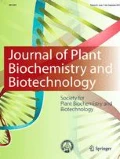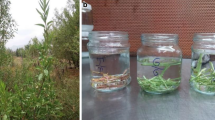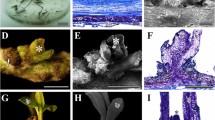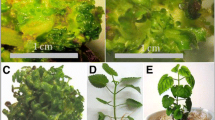Abstract
In the present study aerial roots were successfully used as explants source for in vitro propagation of Cymbidium aloifolium and Cymbidium iridioides. Aerial roots of ~5–6 week old from axenic cultures were cultured on MS medium adjuncts with different additives. In C. aloifolium within 20 days of culture ~60% of explants responded positively on MS medium containing sucrose (3%, w/v) and Kn (3 μM) and formed PLBs. While in C. iridioides ~50% root explants responded positively on medium enriched with sucrose (3%), AC (0.1%) and IAA (3 μM) after 40 days of culture. The shoot buds/PLBs converted into plantlets when maintained on regeneration medium. Of the three basal media tested, MS medium supported optimum regeneration and culture proliferation in both the species. In C. aloifolium ~12 shoot buds developed on medium nourished with sucrose (3%) and BA (3 μM) but in C. iridioides optimum regeneration was achieved when medium supplemented with sucrose (3%), CW (15%), CH (100 mg L−1) and ~20 shoot buds formed per subculture. The well rooted plantlets were acclimatized for 3–4 week in 1/10th MS salt solution containing sucrose (1%), charcoal pieces, brick pieces and chopped mosses as support under normal laboratory conditions. The hardened plants were transferred to potting mix where 80 and 75% of transplants survived in C. aloifolium and C. iridioides respectively after 2 months of transfer.

Similar content being viewed by others
Abbreviations
- BA:
-
Benzyl adenine
- 2,4-D:
-
2,4 dichlorophenoxy acetic acid
- IAA:
-
Indole 3 acetic acid
- Kn:
-
Kinetin
- NAA:
-
α-naphthalene acetic acid
- PLBs:
-
Protocorm-like bodies
References
Agnihotri S, Singh SK, Jain M, Sharma M, Sharma AK, Chaturvedi HC (2004) In vitro cloning of female and male Carica papaya through tips of shoots and inflorescences. Indian J Biotech 3:235–240
Bejoy M, Kumar CS, Radhika BJ, Joemon J (2004) Asymbiotic seed germination and early seedling development of the Dove orchid Peristeria elata Hook. J Orchid Soc India 17:75–79
Chen TY, Chen JT, Chang WC (2004) Plant regeneration through direct shot bud formation from leaf cultures of Paphiopedilum orchids. Pl Cell Tiss Org Cult 76:11–15
Churchill ME, Ball EA, Arditti J (1972) Tissue culture of orchids-II methods for root tips. Amer Orchids Soc Bull 41:726–730
Deb CR, Temjensangba (2005) In vitro regenerative competence of Cleisostoma racemiferum (Orchidaceae) aerial roots. J Pl Biochem Biotech 14:35–38
Deb CR, Temjensangba (2006a) On the regeneration potential of Arachnis labrosa (Lindl. Ex. Paxt.) Reichb. root segments: a study in vitro. Phytomorphology 56:79–83
Deb CR, Temjensangba (2006b) In vitro propagation of threatened terrestrial orchid, Malaxis khasiana Soland ex. Swartz through immature seed culture. Indian J Exp Biol 44:762–766
Deb CR, Temjensangba (2007) Direct regeneration of shoot buds in Arachnis labrosa foliar explants. J Orchid Soc India 21:7–9
Deb CR, Imchen T (2008) Orchid diversity of Nagaland. SciChem Publishing House, Udaipur, Rajasthan, India
Deb CR, Imchen T (2010) An efficient in vitro hardening technique of tissue culture raised plants. Biotechnology 9(1):79–83
Deb CR, Sungkumlong (2010) Regenerative competence of foliar explants of Coelogyne suaveolens and Taenia latifolia: two threatened orchids of North-East India. Appl Biol Res 12:1–9
Deb CR, Deb MS, Jamir NS, Imchen T (2009) Orchids in indigenous system of medicine in Nagaland, India. Pleione 3:209–211
Gill NK, Gill R, Gosal SS (2004) Factors enhancing somatic embryogenesis and plant regeneration in sugarcane (Saccharum officinerum L.). Indian J Biotech 3:119–123
Kosir P, Skof S, Luthar Z (2004) Direct shoot regeneration from nodes of Phalaenopsis orchids. Acta Agriculturae Slovenica 83:233–242
Knudson L (1946) A new nutrient solution for germination of orchid seeds. Amer Orchid Soc Bull 15:214–217
Martin KP (2007) Micropropagation of bamboo orchid (Arundina graminifolia D. Don. Hochr. through protocorm-like bodies using node explants. Propagation Ornamental Pl 7:97–100
Mazumder PB, Sharma GD, Choudhury MD, Nath D, Talukdar AD, Mazumder B (2010) In vitro propagation and phytochemical screening of Papilionantheteres. Assam Univ J Sci Tech Biol Env Sci 5(1):37–42
Medhi RP, Chakrabarti S (2009) Traditional knowledge of NE people on conservation of wild orchids. Indian J Trad Know 8:11–16
Mitra GC, Prasad RN, Roy Chowdhury AR (1976) Inorganic salts and differentiation of protocorm in seed callus of an orchid and correlation changes in its free amino acid content. Indian J Exp Biol 14:350–351
Morel G (1960) Producing virus-free Cymbidiums. Amer Orchid Soc Bull 29:495–497
Murashige T, Skoog F (1962) A revised medium for rapid growth and bioassays with tobacco tissue culture. Physiol Plantarum 15:473–497
Philip VJ, Nainar SAZ (1988) In vitro transformation of root meristem to shoot and plantlets in vanilla planifolia. Ann Bot 61:143–149
Pongener A, Deb C (2009) Asymbiotic culture of immature embryos, mass multiplication of Cymbidium iridioides D. Don. and the role of different factors. Intl J Pharma Bio Sci 1(1):1–14
Pongener A, Deb CR (2011) In vitro mass multiplication of Cymbidium aloifolium using immature embryos as explant. J Pl Biochem Biotech 20:90–95. doi:10.1007/s13562-010-0031-4
Reddy KN, Subba Raju GV, Reddy CS, Raju VS (2005) Ethnobotany of certain orchids of Wastern Ghats of Andra Pradesh. EPTRI-ENVIS Newslet 11(3):5–9
Sungkumlong, Deb CR (2008) Effects of different factors on immature embryo culture, PLBs differentiation and rapid mass multiplication of Coelogyne suaveolens (Lindl.) Hook. Indian J Exp Biol 46:243–248
Sungkumlong, Deb CR (2009) Regeneration competence of Taenia latifolia (Lindl.) Benth. Ex. Hook. Pseudobulb segments: a study in vitro. Indian J Biotech 8:121–126
Temjensangba, Deb CR (2005) Regeneration and mass multiplication of Arachnis Labrosa (Lindl.ex Paxt.) Reichb: a rare and threatened orchid. Curr Sci 88:1966–1969
Vij SP, Pathak P, Mahant KC (1997) On the regeneration competence of Coelogyne viscose pseudobulb explants. In: Vij SP (ed) Proceedings of 5th National seminar on developmental biology and commercialization of orchids. The Orchid Society of India, Chandigarh, India. P 88
Vij SP, Aggarwal S, Pathak P (2004) Regeneration competence of Cymbidium Great Waltz x valley flower roots: a study in vitro. J Orchid Soc India 18:109–115
Acknowledgement
Authors are thankful to the Vice Chancellor, Nagaland University for the basic facilities for the present study and UGC fellowship to Miss. Aolemla Pongener.
Author information
Authors and Affiliations
Corresponding author
Electronic supplementary materials
Below is the link to the electronic supplementary material.
Supplementary Table 1
Effects of PGRs on culture initiation from aerial roots (5–6 wk old) of C. iridioides from in vitro source (DOC 24 kb)
Supplementary Table 2
Effects of different PGRs on plant regeneration and mass multiplication of C. aloifolium* and C. iridioides** (DOC 25 kb)
Rights and permissions
About this article
Cite this article
Deb, C.R., Pongener, A. Studies on the in vitro regenerative competence of aerial roots of two horticultural important Cymbidium species. J. Plant Biochem. Biotechnol. 21, 235–241 (2012). https://doi.org/10.1007/s13562-011-0099-5
Received:
Accepted:
Published:
Issue Date:
DOI: https://doi.org/10.1007/s13562-011-0099-5




